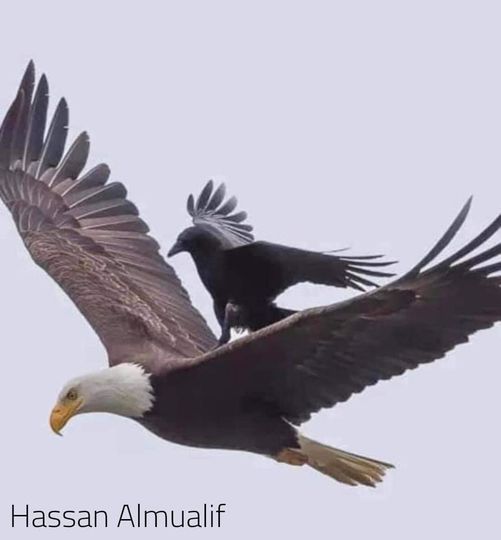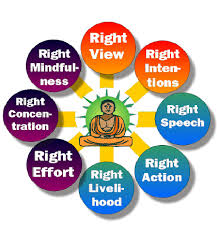The only bird that dares to peck an eagle is the crow. The crow sits on the eagles back and bites his neck. The eagle does not respond, nor fight with the crow; it does not spend time or energy on the crow, instead he just opens its wings and begins to rise higher in the heavens. The higher the flight, the harder it is for the crow to breathe and eventually the crow falls off due to a lack of oxygen.Learn from the eagle and don’t fight the crows, just keep ascending. They might be along for the ride but they’ll soon fall off. Do not allow yourself to succumb to the distractions….keep your focus on the things above and continue rising!!
~ Hassan Almualif
Consume mindfully.
- Eat with awareness and gratitude.
- Pause before buying and see if breathing is enough.
- Pay attention to the effects of media you consume.
Pause. Breathe. Listen.
- When you feel compelled to speak in a meeting or conversation, pause.
- Breathe before entering your home, pleace of work, or school.
- Listen to the people you encounter. They are buddhas.
Practice gratitude.
- Notice what you have.
- Be equally grateful for opportunities and challenges.
- Share joy, not negativity.
Cultivate compassion and loving kindness.
~ B.K.S. Iyengar, “Light on Yoga”
I really wanted to stay in bed this morning. After a string of unusually hot and still days, our wonderful tradewinds have returned. It was nice and cool, as I lay under my sheet, lost in a dream. But a lone seagull’s call kept piercing my silence, almost like I’d put my alarm on snooze.
So I got up. This is my yoga practice.
Even on mornings where I’ve been up until all hours, drinking and chatting on the phone with a friend, I get up. This is the lesson my yoga teacher, Marshan, instilled in me. She said that I must learn to get to my mat, no matter what. Even if it is just to lie in shavasana (corpse pose) on my back, and fall back asleep there, I must still make it to my mat. There have been mornings that I have not written my post, but rest assured, I more than likely got up, and took my photographs, sitting in meditation, if only for a brief couple of minutes.
Why do we practice? I was really lost in some deep thought this morning, as I was thinking about three of my closest friends in the world.
One friend is nearing the completion of her 500 hour teacher training, and will be certifying her first group of students. This is quite an achievement, because this 250 hours, has taken her close to 3 years to fulfill. I was thinking about a conversation I shared with her over the weekend, about a personal challenge she is having with family, and how she is using her practice to remain focused amidst the drama. And while her asana practice, that of the postures on the mat, puts my asana practice to shame, my philosophical practice is a bit stronger than hers, and I was able to share a slightly different approach to the issue.
She was using the 5th limb of yoga – Pratyahara or sense withdrawal – to stay grounded in herself. Unfortunately, this came across as being aloof, to the point of expressed hatred. I shared with her my thoughts via Pema Chodron. It is easy in sense withdrawal, to have to work at it, which adds tension. We must be like the Buddha, and allow the mud to settle on it’s own. Thus there is no resistance, and we can keep a loving, open, compassionate heart.
I thought about my second friend, who has just begun her commitment to a mysore astanga practice, with the aid of a private teacher. She found herself struggling with the knowledge that this was going to be a very personal commitment to self-care. I hope that the opening quote by Iyengar does indeed shed light on how and why she can approach her mat. As students, it’s why the philosophic study is just as important as the physical practice. My asana practice is slight, not needed as much as some may need it, to move into sense withdrawal and meditation, in the ultimate hope of reaching samadhi, or a state of union with the divine. There is no samadhi, with struggle or resistance.
The more I began to think about Patanjali’s 8 limbs of yoga, I realize that I too must return to my mat, for asana practice, if I am to continue to progress further in my own understanding.
Which brings me to my third friend, a brand new practitioner, who has asked my help, in wanting to learn the practice. I’m not overly comfortable teaching asana. And yet, if I come back to the real reason of why we practice, I can be his teacher. I can teach the discipline. I can teach astanga, because it is a set of postures, which do not require me to make up a practice, as in vinyasa. I can teach the philosophy. I can share my energy, and my understanding, and my heart, and my love of spiritual yoga.
B.K.S. Iyengar said further:
“Yoga is to unite the body, mind and intelligence with the depth of the soul. It is a science that liberates one’s mind from the bondage of the body and leads it towards the soul. Yoga is meant for individual growth and for physical, emotional, intellectual and spiritual obstructions to be removed. It is designed for the removal of fluctuations and afflictions, pains and sorrows … allowing one to enjoy the pleasures of the world and to be free from dis-ease.”
In the coming weeks, I’ll be sharing with you Patanjali’s Yoga Sutra. Why we practice must be understood, first and foremost. And from here, yes, I will teach my friend asana …
(And thank God, my own teacher is moving her studio to a larger space, above Randy’s, due to open next week, where my friend and I can attend asana class, and my friend can chuckle with me as to why I don’t consider myself an asana teacher!)
Namaste. To the mat I shall return ….








